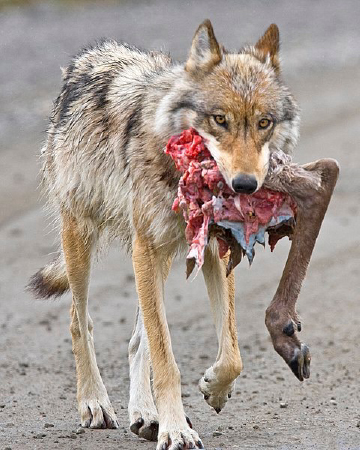BARF ?
Mimicking the human ‘paleo’ craze, dog food manufacturers package and sell raw meats and bones. There are also dog owners who make their own raw meat formulations at home. Several acronyms have been used to describe raw meat-based diets. My personal favorite is BARF which stands for Bones And Raw Foods. BARFs can contain raw muscle, fat, organs, cartilage, and bones from various farm and game animals and fish.
To be clear, these raw foods have not been heated or extruded, two processes commonly used in the food industry as critical control points to reduce the microbial load and increase safety and shelf-life. [1] Commercial raw dog foods are usually frozen or freeze-dried and must remain in the cold chain until fed.
Some are complete diets, similar to complete dry or canned dog foods, and require no supplementation. Some commercial raw foods supplement meals – a ‘topper’ to increase the palatability and desirability of complete rations.
Doggie Daddy Motivations
When surveyed, dog owners who fed BARFs said they were motivated for many reasons:
- respect for their pet’s carnivorous inclinations
- improving their dog’s health
- lack of trust of commercial brands
- preference for fresh ingredients.
 Another goal was to provide a diet that mimics wolves and other wild cousins and meets a dog’s behavioral need to chew. Since domestication and co-evolution with humankind, the dog’s teeth, digestive system, and metabolism has diverged significantly from their wild brethren. For example, a dog can digest starch much better than a wolf. Smaller breeds like pugs and chihuahuas don’t have the dental ‘chops’ needed to grind meat and bone sufficiently before swallowing. Despite their “wild” heritage, our canines have evolved away from an all-meat diet.
Another goal was to provide a diet that mimics wolves and other wild cousins and meets a dog’s behavioral need to chew. Since domestication and co-evolution with humankind, the dog’s teeth, digestive system, and metabolism has diverged significantly from their wild brethren. For example, a dog can digest starch much better than a wolf. Smaller breeds like pugs and chihuahuas don’t have the dental ‘chops’ needed to grind meat and bone sufficiently before swallowing. Despite their “wild” heritage, our canines have evolved away from an all-meat diet.
Dog Food Ingredient Recalls Lower Consumer Confidence
The pet food industry has had scandalous recalls and high-profile lawsuits concerning ingredients. In 2007, melamine adulteration in some pet foods resulted in sicknesses and deaths to dogs and cats. After investigation, it was found that melamine was added to certain imported vegetable proteins by unscrupulous suppliers to make the protein content test higher than it actually was.
Excessive levels of vitamin D, which can cause kidney failure and death, continue to plague dog food manufacturers and spur recalls. When meat from the throat region of an animal is accidentally included in a dog food formulation, there may be adulteration with thyroid hormones, causing excessive thirst, urination, and excitability in canines. There was a recall of dog treats with thyroid adulteration in 2018.
There was a lawsuit in 2014 when Purina sued another pet food manufacturer, Blue Buffalo, who claimed that they used only deboned chicken and chicken meal in their formulations. It came to light that they were using chicken by-products that contained feathers and other low-quality ingredients in the dog food.
Recently, grain-free dog foods containing high legume (pea) and potato content was found to cause heart problems in some larger dog breeds. Despite these recalls and lawsuits, avoiding commercial or dry and going raw doesn’t ensure good nutrition or safety for our pups.
Raw Risks
Few studies have been conducted on the health effects of raw meat and bones fed to domestic dogs. Most of the benefits cited are anecdotal and come from raw food purveyors and supporters themselves. They claim that raw diets improve a canine’s coat and skin, improve muscle mass, and reduce dental diseases. However, many undesirable consequences have been well documented. There is a high risk of feeding incomplete and unbalanced meals if the food is prepared at home without expert input from veterinarians or certified nutritionists.
When dogs consume incomplete or unbalanced daily meals, they can develop rickets (soft bones), hyperparathyroidism, mineral deficiencies, and depression. Feeding unbalanced or inadequate diets to young animals can hinder their growth and development. Fractured teeth, gut obstructions, or stomach perforations have been reported due to bone fragments in raw foods.
Pathogenic bacteria easily contaminate raw meats. Parasites such as tapeworm can be present and active if the BARF is not frozen. A recent study of 12 raw dog food producers found that 28% of the products contained pathogens. There have been many recalls of commercial dog BARFs due to adulteration with pathogens. They are so numerous that only links to the Food Safety Newsletter raw pet food blog and the most recent recall are provided here. In contrast, most commercial dry and canned dog foods are heat and/or pressure-treated and rarely contaminated.
Dogs infected with these pathogens are often asymptomatic and can pass germs on to their owners and families through their feces, licking, sharing a bed, cross-contamination of household surfaces, and food bowls. Vacuum cleaner bags from households feeding BARFs has been shown to be frequently contaminated with Salmonella, a potent diarrhea-causing pathogen.
Raw Recommendations
Surveys have found that most dog owners are unaware of the risks and rely on questionable sources such as the internet for advice on pet nutrition. Here are some science-based safety recommendations for feeding raw: 
- Pet owners should be aware of the risks of feeding raw to dogs and take added precautions to prevent transmission of bacteria and parasites from dogs to humans.
- Pet owners with small children, elderly or immune-compromised family members should reconsider this feeding option. Pet therapy dogs taken to nursing homes and other similar facilities should not be fed raw diets.
- Storage and handling procedures for BARFs should be carefully followed.
- If you wish to make your raw food at home, rely on veterinarians and board-certified nutritionists to help you formulate and prepare complete and balanced dog food diets. Raw meats aren’t as nutritionally dense or fortified as commercial dog foods.
- Consider making BARFs as a topper for complete dry dog food. This will increase the desirability of the dry food and guarantee optimal nutrition for your fur child.
[1] For example, all commercial-grade sushi is frozen before sale to kill possible parasites.




